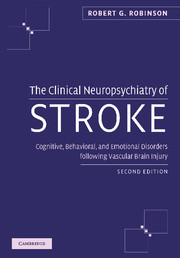 The Clinical Neuropsychiatry of Stroke
The Clinical Neuropsychiatry of Stroke Book contents
- Frontmatter
- Contents
- Preface
- Part I Introduction
- Part II Poststroke depression
- 5 Diagnosis of depression
- 6 Prevalence of depressive disorders
- 7 Phenomenology and specificity of depressive symptoms
- 8 Natural course of depression
- 9 Delayed-onset depression
- 10 Relationship to lesion location
- 11 Relationship of depression to cerebral dominance and structural asymmetries
- 12 Relationship of depression to bilateral hemisphere brain injury
- 13 Relationship of depression to physical impairment
- 14 Relationship to cognitive impairment and treatment
- 15 Relationship of aphasia to depression
- 16 Relationship of depression to social functioning
- 17 Relationship to premorbid risk factors
- 18 Mortality and treatment
- 19 Suicidal thoughts and plans
- 20 Biological markers
- 21 Mechanisms of poststroke depression
- 22 Treatment of poststroke depression
- 23 Prevention of poststroke depression
- Part III Poststroke mania
- Part IV Poststroke anxiety disorders
- Part V Other poststroke disorders
- Index
6 - Prevalence of depressive disorders
from Part II - Poststroke depression
Published online by Cambridge University Press: 01 October 2009
- Frontmatter
- Contents
- Preface
- Part I Introduction
- Part II Poststroke depression
- 5 Diagnosis of depression
- 6 Prevalence of depressive disorders
- 7 Phenomenology and specificity of depressive symptoms
- 8 Natural course of depression
- 9 Delayed-onset depression
- 10 Relationship to lesion location
- 11 Relationship of depression to cerebral dominance and structural asymmetries
- 12 Relationship of depression to bilateral hemisphere brain injury
- 13 Relationship of depression to physical impairment
- 14 Relationship to cognitive impairment and treatment
- 15 Relationship of aphasia to depression
- 16 Relationship of depression to social functioning
- 17 Relationship to premorbid risk factors
- 18 Mortality and treatment
- 19 Suicidal thoughts and plans
- 20 Biological markers
- 21 Mechanisms of poststroke depression
- 22 Treatment of poststroke depression
- 23 Prevention of poststroke depression
- Part III Poststroke mania
- Part IV Poststroke anxiety disorders
- Part V Other poststroke disorders
- Index
Summary
The prevalence of poststroke depression has been assessed in a large number of patients who have been examined in various settings throughout the world. Since the first edition of this text, large numbers of patient populations have been added to the literature and pooling of the data has provided prevalence rates based on more than 6000 patients. There are at least three factors which have complicated the determination of prevalence rates. The first is the setting in which patients were examined. Community studies have generally reported somewhat lower prevalence rates than studies done in hospital outpatient settings. Community studies have generally included many patients who had very mild or frequently no motor sensory or other neurological symptoms associated with their stroke. Thus, some of these patients have such minimal brain injury that they would not be expected to have stroke-induced depression. On the other hand, patients with more severe motor sensory or other physical symptoms of stroke who have been hospitalized would be expected to have more severe brain damage and higher rates of depression reflecting the association between severity of depression and severity of physical impairments associated with stroke.
The second factor which has complicated prevalence studies of poststroke depression is the number of patients who are excluded from studies of poststroke depression.
- Type
- Chapter
- Information
- The Clinical Neuropsychiatry of StrokeCognitive, Behavioral and Emotional Disorders following Vascular Brain Injury, pp. 52 - 59Publisher: Cambridge University PressPrint publication year: 2006
- 1
- Cited by


